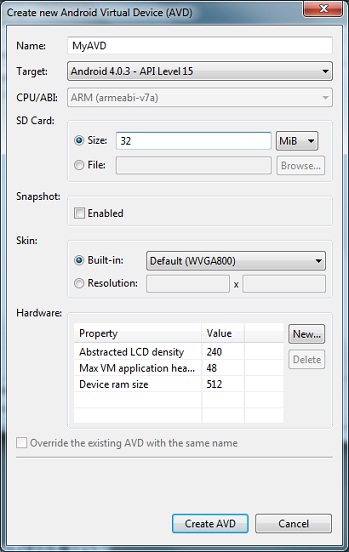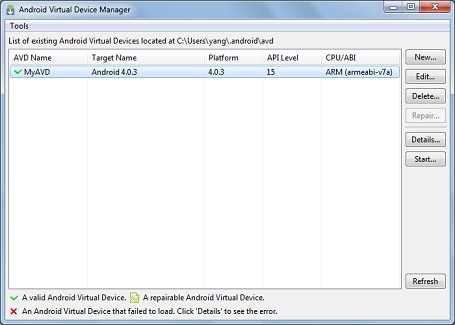Android Tutorials - Herong's Tutorial Examples - v3.03, by Herong Yang
Outdated: Creating Android Virtual Device (AVD)
This section provides a tutorial example on how to create an Android Virtual Device (AVD), which is an emulator configuration that lets you to model an actual Android device.
This tutorial was based on Android SDK R17 with Android 4.0.3 and left here as a reference.
In order to run the Android emulator on your Windows system, you need to create an Android Virtual Device (AVD), which is an emulator configuration that lets you to model an actual device by defining hardware and software options to be emulated by the Android Emulator.
Here is what I did to create an AVD:
1. Double-click on "C:\local\android-sdk-windows\AVD Manager.exe". The "Android Virtual Device Manager" window shows up.
2. Click "New" button. The "Create new Android Virtual Device (AVD)" window shows up:

3. Keep all default values and enter these new values:
Name: MyAVD Target: Android 4.0.3 - API Level 15 SD Card/Size: 32 MiB
4. Click "Create AVD" button. The "Result of creating AVD 'MyAVD'" message box shows up.
5. Click "OK" to close the message box. A new AVD "MyAVD" is listed in the "Android Virtual Device Manager" window now.

Read the next tutorials on how to run an Android emulator with the AVD you created on your Windows system.
Table of Contents
Installing JDK 1.8 on Windows System
Installation of Android SDK R24 and Emulator
Installing Apache Ant 1.9 on Windows System
Developing First Android Application - HelloAndroid
Android Application Package (APK) Files
Android Debug Bridge (adb) Tool
AboutAndroid - Application to Retrieve System Information
android.app.Activity Class and Activity Lifecycle
View Objects and Layout Resource Files
Using "adb logcat" Command for Debugging
Build Process and Package File Content
Samsung Galaxy Tab 3 Mini Tablet
USB Debugging Applications on Samsung Tablet
USB Debugging Applications on LG-V905R Tablet
USB Debugging Applications on LG-P925g Phone
Outdated: Downloading and Installing JDK 1.7
Outdated: Downloading and Installing Android SDK R17
Outdated: Running Android SDK Manager
Outdated: Installing Android Platform 4.0.3 and Libraries
Outdated: Verifying Android Platform Installation
►Outdated: Creating Android Virtual Device (AVD)
Outdated: Launching Android Emulator in AVD Manager
Outdated: Android Emulator Built-in Applications
Outdated: Android Emulator Built-in Web Browser
Outdated: Downloading and Installing Apache Ant 1.8
Outdated: "HelloAndroid" - First Android Project
Outdated: Building the Debug Binary Package
Outdated: Installing the Debug Binary Package
Outdated: Running the Debug Binary Package
Outdated: Rebuild the Debug Binary Package
Outdated: Redefine Text in Resource Files
Outdated: Installing Android PDF Viewer APK File
Outdated: Copy PDF File to Android Emulator's File System
Outdated: Installing Adobe Reader APK File
Outdated: "adb shell" - Remote Shell Interface